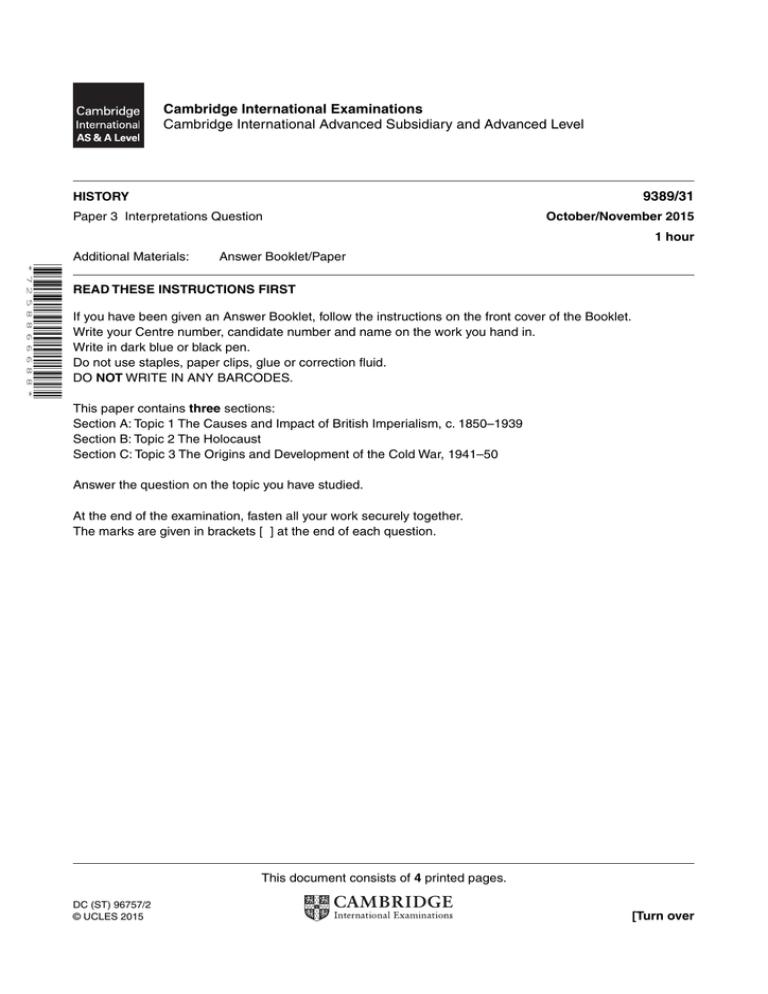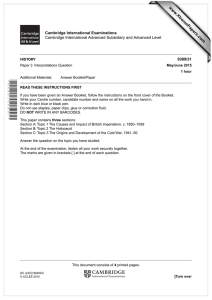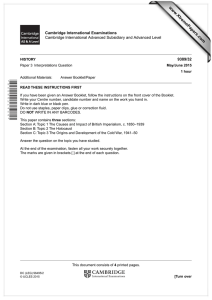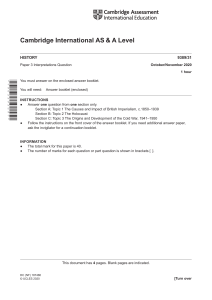9389_w15_qp_31
advertisement

Cambridge International Examinations Cambridge International Advanced Subsidiary and Advanced Level 9389/31 HISTORY Paper 3 Interpretations Question October/November 2015 1 hour Additional Materials: Answer Booklet/Paper * 7 2 5 8 8 6 6 6 8 8 * READ THESE INSTRUCTIONS FIRST If you have been given an Answer Booklet, follow the instructions on the front cover of the Booklet. Write your Centre number, candidate number and name on the work you hand in. Write in dark blue or black pen. Do not use staples, paper clips, glue or correction fluid. DO NOT WRITE IN ANY BARCODES. This paper contains three sections: Section A: Topic 1 The Causes and Impact of British Imperialism, c. 1850–1939 Section B: Topic 2 The Holocaust Section C: Topic 3 The Origins and Development of the Cold War, 1941–50 Answer the question on the topic you have studied. At the end of the examination, fasten all your work securely together. The marks are given in brackets [ ] at the end of each question. This document consists of 4 printed pages. DC (ST) 96757/2 © UCLES 2015 [Turn over 2 Section A: Topic 1 The Causes and Impact of British Imperialism, c.1850–1939 1 Read the extract and then answer the question. Gentlemanly capitalism undoubtedly helped to promote expansionist forces of investment, commerce and migration. The resulting expansion of global commerce was to be handled, transported and insured by British firms. British manufactured exports were a very visible part of the panorama, but the design was not drawn by industrialists and their interests were not paramount. This vision was not inevitably imperialistic; nor were its imperialist forms invariably militaristic. Nevertheless, there was a tendency for expansionist impulses to become imperialist, especially where they came up against societies which needed reforming or restructuring before expansionist ambitions could be realised, and which also seemed to be either amenable to change or incapable of resisting it. Representatives of the service sector formed the advance guard of capitalism abroad. In promoting their interests, they necessarily came into direct contact with potential clients, customers and producers in distant parts of the world in ways that British manufacturers did not. Not surprisingly, those in the front line gathered much of the information that reached London, passed on judgements about the suitability of foreign countries for the role assigned to them, and made recommendations about how they might be aligned to fit Britain’s international purpose. The marriage of private and public interests was readily arranged, partly because of the increasing importance of invisible earnings and income from foreign investment, and partly because the gentlemen at the top of the banking and service hierarchy shared the values and spoke the language of the political decision-makers. But the resulting alliance was much more than a narrow sectional deal between segments of the elite. Put simply, overseas expansion and the imperialism which accompanied it played a vital role in maintaining property and privilege at home in an age of social upheaval. The link between the domestic and overseas parts of this strategy was forged by the British gentleman abroad. He was perfectly placed to ease the transition from expansion to imperialism by using an ideology of mission and making it patriotic. It is no coincidence that the most pervasive images of imperialism and empire were those which projected gentility rather than industry. The public portrait of the imperial world was framed by civic virtues and depicted manly exploits, country life on estates and plantations, and social gatherings under tropical verandahs. By stretching a point, it was possible to speak of the ‘romance of the steamship’; but the chivalry of empire never embraced the factories of Birmingham or Manchester. Imperialism was neither an addition to the mainstream of British history nor an expression of a particular phase of its industrial development, but an integral part of the nature of a British society which it both reinforced and expressed. Imperialist enterprise was enfolded in a grand development strategy designed by Britain to reshape the world in its own image. It was spearheaded, not by manufacturing interests, but by gentlemanly elites who saw in empire a means of generating income flows in ways that were compatible with high ideals of honour and duty. What can you learn from this extract about the interpretation and approach of the historian who wrote it? Use the extract and your knowledge of the British Empire to explain your answer. [40] © UCLES 2015 9389/31/O/N/15 3 Section B: Topic 2 The Holocaust 2 Read the extract and then answer the question. The Final Solution had its origins in Hitler’s mind. In Mein Kampf he tells us that he decided on his war against the Jews in 1918 when, in the military hospital at Pasewalk, he learned of the armistice. Through a maze of time this decision of 1918 led to Operation Barbarossa in 1941. There was never any ideological deviation or wavering determination. In the end, only the question of opportunity mattered. The Final Solution grew out of a matrix formed by traditional anti-Semitism, the paranoid delusions that seized Germany after World War I, and the emergence of Hitler and the National Socialist movement. Without Hitler, the charismatic political leader, who believed he had a mission to annihilate the Jews, the Final Solution would not have occurred. Without that assertive and enduring tradition of anti-Semitism by which the Germans sought self-definition, Hitler would not have had the fertile soil in which to grow his organisation and spread its propaganda. Without the paranoid ‘stab-in-the-back’ delusions that masses of Germans shared in the wake of Germany’s military defeat, political upheavals, economic distress, and humiliations of the Versailles Treaty, Hitler could not have transformed the German brand of conventional anti-Semitism into a radical doctrine of mass murder. Anti-Semitism was the core of Hitler’s system of beliefs and the central motivation for his policies. He believed himself to be the saviour who would bring redemption to the German people through the annihilation of the Jews. The murder of Jews, in his fantasies, was commanded by divine providence, and he was the chosen instrument for that task. He referred often to his ‘mission’, but nowhere so explicitly as in Mein Kampf: ‘Hence today I believe that I am acting in accordance with the will of the Almighty Creator: by defending myself against the Jew, I am fighting for the work of the Lord.’ From the moment he made his entrance on the historical stage until his death in a Berlin bunker, this sense of mission never departed from him, nor could any appeal to reason deflect him from pursuing his murderous purpose. Generations of anti-Semitism had prepared the Germans to accept Hitler as their redeemer. Layer upon layer of anti-Semitism of all kinds – Christian church teachings about the Jews, Volkist antiSemitism, doctrines of racial superiority, economic theories about the role of Jews in capitalism and commerce, and a half-century of political anti-Semitism – were linked with German nationalism, providing the structural foundation upon which Hitler and the National Socialist movement built. Of all the appeals that the NSDAP directed at the German people, its racial doctrine was the most attractive. For the average National Socialist, and still more for the party’s fellow travellers, out of the whole set of racial teachings, the anti-Jewish doctrine had the greatest dynamic strength. The reports of early NSDAP meetings reveal, from the record of audience responses, that violent attacks on the Jews provided frenzied outbursts and that Hitler was most adept at getting the blood to tingle with his threats against the Jews. For the audience, the convolutions of Hitler’s ideology were, in the end, reduced in significance to the timeworn slogan of German anti-Semitism: ‘Death to the Jew’. What can you learn from this extract about the interpretation and approach of the historian who wrote it? Use the extract and your knowledge of the Holocaust to explain your answer. [40] © UCLES 2015 9389/31/O/N/15 [Turn over 4 Section C: Topic 3 The Origins and Development of the Cold War, 1941–1950 3 Read the extract and then answer the question. The Cold War’s roots in the Second World War help to explain why this new conflict emerged so quickly after the old one had come to an end. But great power rivalries had long been at least as normal a pattern in the behaviour of nations as had great power alliances. Anyone, aware of this, might well have expected exactly what took place. Certainly a theorist of international relations would have. The interesting question is why the wartime leaders themselves were surprised, even alarmed, by the breakdown of the Grand Alliance. Their hopes for a different outcome were real enough; otherwise they would hardly have made the efforts they did while the fighting was going on to agree on what was to happen when it stopped. Their hopes were parallel – but their visions were not. To frame the issue in its most basic terms, Roosevelt and Churchill envisaged a post-war settlement which would balance power while embracing principles. The idea was to prevent any new war by avoiding the mistakes that had led to World War II: they would ensure cooperation among the great powers, revive Wilson’s League in the form of a new United Nations collective security organisation, and encourage the maximum possible political self-determination and economic integration, so that the causes of war as they understood them would in time disappear. Stalin’s was a very different vision: a settlement that would secure his own and his country’s security while simultaneously encouraging the rivalries among capitalists that he believed would bring about war between them. This inevitable capitalist self-destruction, in turn, would ensure the eventual Soviet domination of Europe. The first was a multilateral vision that assumed the possibility of compatible interests, even among incompatible systems. The second assumed no such thing. Political scientists like to speak of ‘security dilemmas’: situations in which one state acts to make itself safer, but in doing so diminishes the security of one or more other states, which in turn try to repair the damage through measures that diminish the security of the first state. The result is an ever-deepening whirlpool of distrust from which even the best-intentioned and most far-sighted leaders find it difficult to extricate themselves: their suspicions become self-reinforcing. Because the Anglo-American relationship with the Soviet Union had fallen into this pattern well before World War II ended, it is difficult to say precisely when the Cold War began. There were no surprise attacks, no declarations of war, no severing even of diplomatic ties. There was, however, a growing sense of insecurity at the highest levels in Washington, London and Moscow, generated by the efforts the wartime allies were making to ensure their own post-war security. With their enemies defeated, there was less of an incentive for these former allies, as they were coming to think of themselves, to keep their anxieties under control. Each crisis that arose fed the next one, with the result that a divided Europe became a reality. What can you learn from this extract about the interpretation and approach of the historian who wrote it? Use the extract and your knowledge of the Cold War to explain your answer. [40] Permission to reproduce items where third-party owned material protected by copyright is included has been sought and cleared where possible. Every reasonable effort has been made by the publisher (UCLES) to trace copyright holders, but if any items requiring clearance have unwittingly been included, the publisher will be pleased to make amends at the earliest possible opportunity. To avoid the issue of disclosure of answer-related information to candidates, all copyright acknowledgements are reproduced online in the Cambridge International Examinations Copyright Acknowledgements Booklet. This is produced for each series of examinations and is freely available to download at www.cie.org.uk after the live examination series. Cambridge International Examinations is part of the Cambridge Assessment Group. Cambridge Assessment is the brand name of University of Cambridge Local Examinations Syndicate (UCLES), which is itself a department of the University of Cambridge. © UCLES 2015 9389/31/O/N/15





